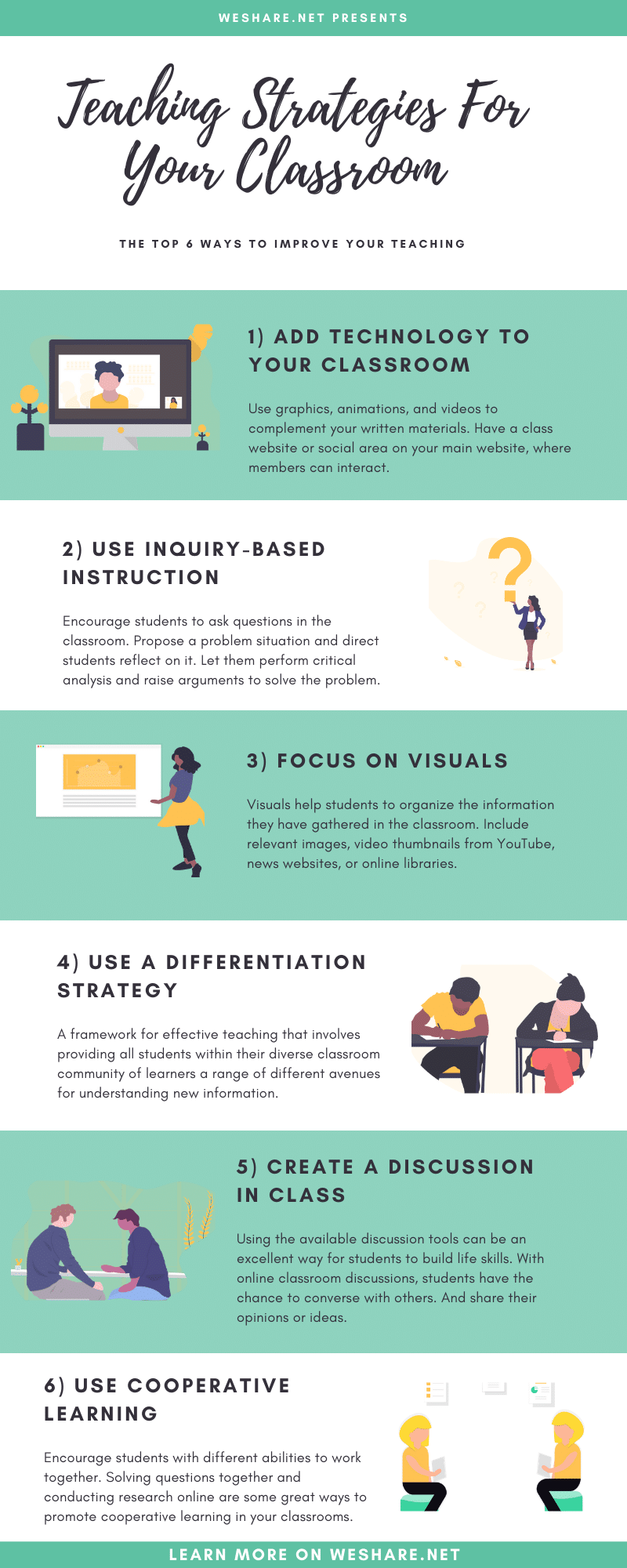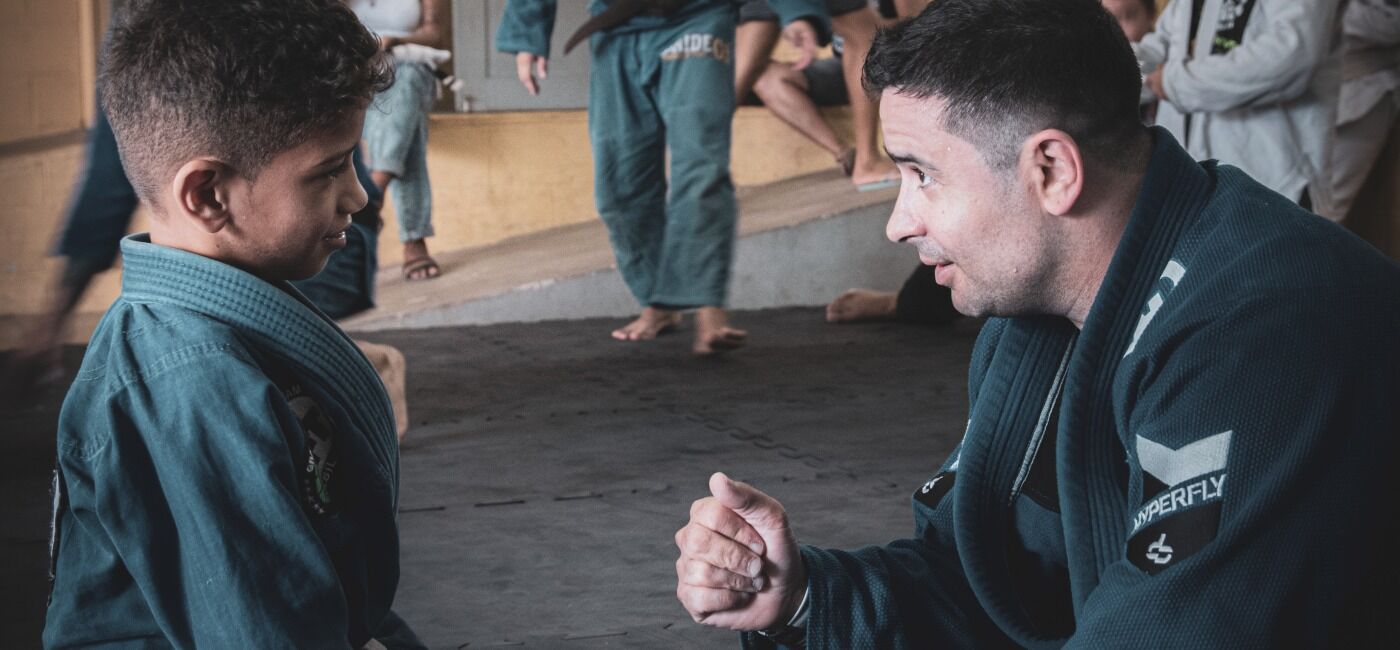Find out what are teacher strategies? Top 12 teaching strategies you can use to improve your classroom today.
Teaching strategies are techniques or methods that teachers and students use to acquire information, build knowledge, etc.
These techniques are essential to get the best performance from students.
And facilitate the acquisition, storage, and use of information.
The quality of teaching is related to students’ learning.
Consequently, excellent teaching strategies are essential to achieve this quality.
In this case, these strategies must be well thought out by the teacher.
Who must be very careful not only in planning.
But also in the execution of these ideas.
Many think that keeping students interested is as easy as following a formula.
Unfortunately, there is no magic that will help engage students.

Each group and each class is different.
Several factors affect a student’s motivation to continue working and learning.
Among them: interest, perception, desire, self-confidence, self-esteem, patience and persistence.
So, when choosing between teacher strategies for online learning.
Analyse if it is suitable for that content.
And if it can positively reach the majority of students in the classroom.
We discuss 12 teaching strategies in the sections below.
That you can use to improve your online teaching.
And make eLearning a fantastic experience for both you and your students.
Table of Contents:
What Are Teacher Strategies?
Top 12 Teaching Strategies For Your Classroom
- Add Technology In The Classroom
- Use Inquiry-Based Instruction
- Focus On Visuals
- Use A Differentiation Strategy
- Create A Discussion In Class
- Set Clear Class Goals And Objectives
- Use Cooperative Learning
- Give Good Examples By Modeling
- Provide Constructive Feedback
- Use Experiential Learning Strategies
- Add Graphic Organizers
- Create A Student-Led Class
#1 Add Technology in The Classroom

Today, many learners own smartphones and tablets.
You can take advantage of this.
And come up with teaching techniques that keep your learners engaged.
Use graphics, animations, and videos to complement your written materials.
Have a class website or social area on your main website, where members can interact.
Or consider organising for an online research project.
Ask students to use their mobile devices – to record experimental results, share quality photos and videos.
All these activities motivate your students and keep them interested in your class.
Also, you can create personalized quizzes online.
Think of a resource like Quizalize.
You can create free online questionnaires.
And can make them available to your students using this online tool.
#2 Use Inquiry-Based Instruction

Teaching isn’t just about passing information.
Good teacher strategies involve developing the soft skills of learners as well.
If you encourage students to ask questions in the classrooms.
You boost their problem-solving skills.
As well as increase their understanding of academic concepts taught in class.
So, propose a problem situation and direct students reflect on it.
Let them perform critical analysis and raise arguments to solve the problem.
For example, at the beginning of the class, you could simulate a problem.
Make sure the answer isn’t obvious.
Instruct students to focus on the lesson to find a solution to the question presented.
At the end of the class, they must offer possible solutions.
Research from Harvard Business Review has shown that a higher curiosity quotient can indicate more flexibility.
And help build a more exceptional ability to handle complexity.
An inquiry-based learning strategy is an excellent tool.
For students to learn how to become problem solvers.
#3 Focus on Visuals
Focusing on visuals helps students to conceptualize and brainstorm ideas easily.
Visuals help students to organize the information they have gathered in the classroom.
To enhance easy comprehension.
You don’t need to be a professional graphics designer to make your online courses more appealing.
Tweak your online presentation.
It can go a long way in helping your students stay focused.
And not to get bored in class.
Do you have a lot of texts and instructions?
You can break up long chunks of texts using subheadings and paragraphs.
Include relevant images, video thumbnails from YouTube, news websites, or online libraries.
Remember, the goal is to make your class lively and not dull.
#4 Use A Differentiation Strategy
According to Wikipedia, differentiated instruction is an efficient philosophy for teaching.
It provides the avenue for students to understand new information.
Regardless of their different abilities.
What does differentiating instructions in online classrooms look like?
It requires the use of different learning and instructional materials as well as practices.
Also, staying updated and playing with new technologies.
This increases the chances of creating differentiated learning environments for all students.
#5 Create A Discussion in Class

This involves creating an online community of learners.
Where engaging conversations can take place.
And this isn’t always easy – it’s a continuous process that takes time and effort to yield results.
However, using the available discussion tools can be an excellent way for students to build life skills.
With online classroom discussions, students have the chance to converse with others.
And share their opinions or ideas.
#6 Set Clear Class Goals and Objectives
Don’t let your students do all the hard work figuring out what they should be learning.
Instead, help them.
Clearly state your goals, objectives, and expectations from the students.
Do this at the beginning of the online course.
This will help the students prepare adequately for the upcoming classes.
Students should be encouraged to become independent.
And self-motivated learners.
As teachers, it is possible to achieve this goal.
By doing frequent monitoring.
And providing feedback for the student to improve.
Opportunities for success can also be guaranteed.
This is by assigning tasks that are not so easy, but also not very difficult.
Strive to keep expectations high in your assessments and interactions.
But not unrealistic.
Setting clear classroom goals and objectives is among the most powerful teaching strategies.
As it helps the student’s routine in online education.
It helps reduce the students’ frustrations come assessment time.
And facilitates the entire learning cycle.
#7 Use Cooperative Learning
Encourage students with different abilities to work together.
It’s a great way of creating bonds and sharing ideas between students.
Through sharing ideas and brainstorming class assignments with others.
Students can develop their self-confidence.
As well as increase their creative thinking and interpersonal skills.
These are skills necessary for everyday life.
Solving questions together and conducting research online,
Are some excellent ways to promote cooperative learning in online classrooms.
Cooperative learning also introduces students and teachers.
And will promote socialization of the group.
And facilitate the first contact between teachers and students.
This will significantly help to strengthen the teaching environment in online education.
#8 Give Good Examples by Modeling
Let’s say you were in a traditional classroom.
And students raise their hands to ask questions.
About a concept that is not clear to them.
What do you do?
You most likely find another way to make them understand what you are teaching.
You come up with simple examples – maybe from real-life events.
Those examples help students understand the information.
In a way that doesn’t confuse them.
Examples are even more important teacher strategies for online students.
Remember the first time you taught a course in college?
Maybe you got some tips from the previous lecturer.
To help you in preparing yours.
Likewise, when you first taught a course online.
You may have used someone else’s material.
To prepare your lecture notes.
Those who created their first online class without any model to follow will agree that it was challenging to produce something new.
Online students also benefit from several explanations of tough concepts.
And different examples of what you are talking about.
To help students learn better and understand the concept you are teaching, you can:
- Source for videos that give a thorough explanation of the course you are teaching.
- Invite a guest lecturer to record a video – enabling the students to listen to an expert in your field.
- Organize the classroom to help students explain new concepts to one another
In addition to providing several examples.
You can also give as many examples of the previous students’ work.
For instance, if it’s an essay writing assignment.
You can show them examples of what you expect from them.
#9 Provide Constructive Feedback
Feedback is an evaluative and critical response.
It aims to highlight the positive and negative points of any activity or attitude.
Many people wonder how to give constructive feedback.
And this is a very justifiable concern.
Since it’s not easy to give or receive criticism.
However, this is among the teacher strategies that are critical and deserve attention.
How do you give constructive feedback to students in an online classroom?
Comparison, if negative, can also reduce motivation.
Focus on comments about the development and improvement of each student.
And never compare them with anyone.
And cause less confidence, emotional control, and decreased performance in an online classroom.
Avoid using texts to send feedback.
Instead, you can send constructive feedback in an audio format.
Ensure you have your notes ready before recording.
And always start with the student’s name when giving feedback.
Other teacher strategies you can try is to encourage peer feedback.
This is where you allow students to review each other’s work.
And providing constructive feedback.
This strategy promotes increased interaction.
And engagement in online classrooms.
#10 Use Experiential Learning Strategies
Experiential learning has been defined differently by several authors.
It has been used as a synonym for discovery learning, interactive learning, transformational learning, active learning, action learning, and brain-based learning.
Also, it is used consciously or unconsciously in structured learning in the classroom.
Besides, it is not something exclusive to corporate training.
It is present in traditional education.
Regardless of its definition, three elements are common.
- There must be a significant experience that serves as input to see academic concepts in action.
- There needs to be an opportunity for reflection to interpret the experience and the emotions associated with it.
- The learner must decide what and how he intends to change in the future, either by applying some new knowledge or by transforming his way of acting.
According to Tony Pont, “People learn 10% of what they read, 20% of what they hear, 30% of what they see, 50% of what they see and hear simultaneously, 70% of what they say and 90% of what they say and do.”
By adopting this teaching strategy.
And incorporating it in highly sophisticated and hi-tech online classrooms.
Learning becomes fun and practical for students.
#11 Add Graphic Organizers
A graphic organizer is a tool or structure that allows you to collect, relate and present information visually.
They can take many forms.
And they include Venn diagrams, story pages, and concept maps.

Information presented in an easy-to-read format can improve thinking.
It can spark new ideas.
And make learners stay focused on the topic or task at hand.
A graphic organizer is intended to provide a framework for ideas or concepts.
Thus facilitating the collection or addition of information.
Once completed, it serves as a presentation or study model.
There’s a significant benefit of incorporating graphic organizers in online classrooms.
And that’s – it guides learners as they build upon a diagram or a visual map.
It is one of the most effective teaching strategies that enhance learning.
And understanding of concepts.
Graphic organizers help students think critically.
They often use them for their writing projects.
Additionally, it can also serve as an instructional tool.
Teachers can use to illustrate a student’s knowledge.
About a particular topic in a course.
#12 Create A Student-Led Class
Peer learning is one of the effective teacher strategies.
Where students tutor one another.
To gain insight into a course.
Or understand a concept that is hard to grasp.
Students of a higher class often guide students in lower classes.

To discuss course materials and solve problems.
Now the question becomes, “how can this be incorporated in online classrooms?”
As an online tutor, you can design your program to allow students who have taken your course in the past to tutor the new guys.
You can invite older students to record educational videos for them.
And share them with the lower class.
This is among the teacher strategies that help students to think about what they have been taught.
And it encourages group learning.
Wrapping Up
The general key to motivating students in online education courses.
Is the incorporation of activities for students to participate in classes.
However, one cannot lose sight of the main objective of the class.
And that’s – to educate.
So, please don’t overdo any of the given teacher strategies.
You have to work to find the right combination.
After all, each student is different.
And each class is different.
If you don’t know what is working in your classes.
If you feel that you are losing students.
Or you know that you aren’t succeeding.
Ask them for feedback.
Maureen Kasyoka is the editor of Weshare’s blog. She has gained excellent research and writing skills through the years, writing on ranging of topics from social media to marketing in more than 5 years.
We Also Reviewed
- 45+ Advertising Statistics That Will Blow Your Mind
- 33 CRM Statistics You Should Know
- 41+ Public Speaking Statistics You Should Know
- 35 Machine Learning Statistics You Should Know
- 34 Employee Burnout Statistics You Should Know
- 39+ Communication Statistics You Need To Know
- 37+ Cold Calling Statistics You Need To Know
- 21+ Entrepreneur Statistics You Should Know
- 35+ Contract Management Statistics You Should Know
- 37+ Zoom Statistics You Should Know
- 35+ Sales Training Statistics You Should Know About
- 75+ WordPress Statistics You Need to Know
- 41+ Startup Statistics You Need to Know
- 37+ Presentation Statistics You Need To Know
- 41+ Recruiting Statistics You Need to Know
- 23+ Apple Podcast Statistics You Should Know About
- 31+ Spotify Podcast Statistics You Should Know About
- 35+ Spotify Statistics You Should Know
